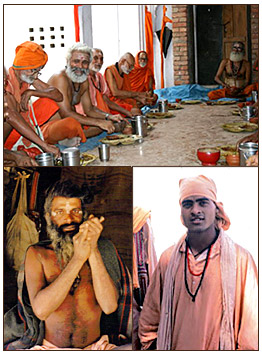 In Hinduism, one who renounces all ties with family and society and pursues spiritual liberation is called a Sannyasi. Sannyasis are a class of Sadhu that do not live in communities, instead leading a mendicant, itinerant life. Those recognized as having achieved full self-knowledge are considered free of all worldly rules and duties including those pertaining to caste and are not required to carry out image worship or offerings. After death their bodies rather than being cremated are buried in a seated meditative posture.
In Hinduism, one who renounces all ties with family and society and pursues spiritual liberation is called a Sannyasi. Sannyasis are a class of Sadhu that do not live in communities, instead leading a mendicant, itinerant life. Those recognized as having achieved full self-knowledge are considered free of all worldly rules and duties including those pertaining to caste and are not required to carry out image worship or offerings. After death their bodies rather than being cremated are buried in a seated meditative posture.
Sannyasi is a Sanskrit word meaning `renunciation` or `abandonment`. Sannyasi is the last of the four stages of life in Hinduism, the others being Brahmachari, Grihasta and Vanaprastha. The stage of Sannyasi is considered the topmost and final stage of the ashram systems. The Sannyasi life is adopted after the age of fifty years. Sannyasi renounces his social life with all his enjoyments, attachments and his passions. In the stage of Sannyasi life the person lives on what is given to him unasked. The lifestyle of the Sannyasi is very much different from the normal life. The Sannyasi lives a life without possessions, desires and wishes. They practice yoga or meditation and bhakti or devotional meditation A Sannyasi remains in a village only for one day, in a town not more than three days, and in a city for only five days in case his mind become secularized.
There are various types of sannyasi in accordance with socio-religious context. By tradition there are four types of forest hermits with different stages of dedication. In recent times there are two distinct orders of Sannyasi, they are observed `ekadanda` or literally single stick and `tridanda` or triple rod or stick the saffron robed monks. Ekadanda is of the Sankaracarya tradition and Tridanda is Sannyasi followed by various Vaishnava traditions. The objective of the Sannyasi is moksha or liberation. According to them the devotional traditions and liberation consists of union with the Divine.




















